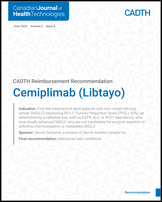|
Type of economic evaluation
| Cost utility analysis Partitioned survival model |
|
Target populations
| Adult patients with non–small cell lung cancer (NSCLC) expressing PD-L1 (Tumour Proportion Score [TPS] ≥ 50%), as determined by a validated test, with no EGFR, ALK or ROS1 aberrations, who have: |
|
Treatment
| Cemiplimab |
|
Submitted price
| $8,200 per 350 mg vial |
|
Treatment cost
| At the submitted price of $8,200 per 350 mg dose, administered intravenously every 3 weeks until progression, the monthly cycle cost of cemiplimab is $11,955.56. |
|
Comparators
|
Pembrolizumab Chemotherapy
|
|
Perspective
| Canadian publicly funded health care payer |
|
Outcomes
| Quality-adjusted life-years (QALYs), life-years (LYs) |
|
Time horizon
| Lifetime (30 years) |
|
Key data sources
| Phase III R2810-ONC-1624 trial and sponsor’s conducted NMA (KEYNOTE-024 trial) |
|
Submitted results
|
The ICER for cemiplimab was $26,521 per QALY when compared to chemotherapy (incremental costs = $56,408; incremental QALYs = 2.13). Pembrolizumab was extendedly dominated through chemotherapy and cemiplimab (i.e., higher ICER than cemiplimab when compared with chemotherapy).
|
|
Key limitations
|
There was high uncertainty in the results from the NMA used to inform the relative efficacy of cemiplimab and pembrolizumab. The networks were sparse and there was a high degree of heterogeneity in baseline characteristics across included trials. The sponsor inappropriately included chemotherapy as a comparator. Clinical experts consulted by CADTH advised that chemotherapy is not an appropriate comparator for cemiplimab. Patients are expected to be treated with chemotherapy only if they are ineligible for immunotherapy in the first-line setting. The OS and PFS extrapolation for cemiplimab and pembrolizumab lacked clinical validity. The PFS and OS for pembrolizumab predicted from the sponsor’s model were substantially lower than those reported in the KEYNOTE-024 trial. The treatment dosage for pembrolizumab and subsequent treatment regimens did not reflect the standard of care in Canada. Health utility values applied for pre-progression and post-progression health states did not align with clinical expectations. The health utility value applied in the sponsor’s model for pre-progression health state was higher than the age-specific general population utility norm, and the utility value for progressed patients did not adequately capture the expected negative impact of cancer progression on health-related quality of life.
|
|
CADTH reanalysis results
|
CADTH performed reanalysis by applying the following changes: excluding chemotherapy as a comparator; assuming equal OS and PFS for cemiplimab and pembrolizumab; using an alternative model to extrapolate PFS; applying weight-based dosing with vial sharing for pembrolizumab; applying the same incidence rates of adverse events for cemiplimab and pembrolizumab; applying alternate health state utility values; and revising subsequent treatment regimens based on clinical expert opinion. Results from CADTH base case showed that cemiplimab resulted in higher costs by $125,981 ($266,281 vs. $140,300) and equal QALYs compared to pembrolizumab. The probability of cemiplimab being cost-effective at a willingness-to-pay (WTP) threshold of $50,000 was 0%. A minimum price reduction of 61% is required for cemiplimab to provide cost-savings when compared with pembrolizumab. Results from scenario analysis showed that when a treatment stopping rule of 2 years was applied to cemiplimab to align with the R2810-ONC-1624 trial and funding criteria for pembrolizumab, cemiplimab had higher costs by $27,090 ($167,390 vs. $140,300) and equal QALYs compared to pembrolizumab. Thus, the cost difference between cemiplimab and pembrolizumab is reduced when a treatment stopping rule of 2 years is applied to cemiplimab. A minimum price reduction of 25% is required for cemiplimab to provide cost-savings when compared with pembrolizumab in this scenario.
|
